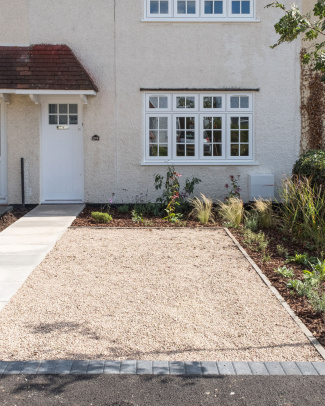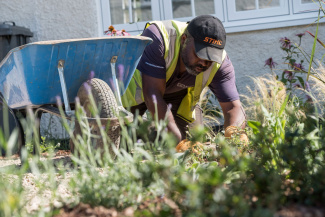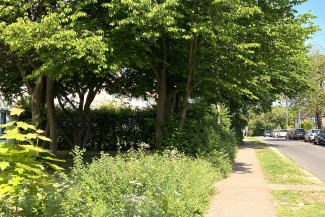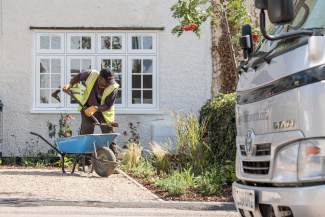Gardening can boost mental wellbeing by reducing anxiety, stress and other types of day-to-day issues that many of us face. The benefits of gardening on our mental wellbeing has been well documented and studied so why not reap the benefits of having a garden? It’s not just the physical activity that we benefit from, surrounding ourselves with greenery also brings us a sense of calm. With environment and wellbeing being in the forefront of many of our minds, it may be beneficial for more of us to dedicate some time to an often overlooked part of our homes.
Front gardens and their upkeep are truly important to the whole character and appearance of a town and they play a vital role in protecting wildlife and the environment. For example, when an area is heavily tarmacked or built over, localised flooding can occur as drains cannot handle heavy rainfall. By retaining soil and plants in your front garden, you can help create an attractive environment that supports wildlife and helps prevent flooding from surface water.
In addition to lawns and gardens easing drainage, greenery also benefits vital wildlife and insects such as bees and hedgehogs. Front gardens have benefits for people too. They can provide screening which creates a private green oasis for enjoyment and healthy living. A green environment also has a positive impact on our mental health.
Claire Pudney from Heritage Advisory Team is here to tell you 5 great things you can do to make your front garden more environmentally friendly:
1. Plan for all year round
To make the most from your green space, it is good to plant shrubs and plants that are evergreen or blossom at different times of the year. Keeping your focus on spring/summer means that other seasons are left out and do not provide an environmentally sound space all year. Look at planting perennials and shrubs such as coneflowers, geraniums and azalea to create a beautiful garden all year long.
Trimming evergreens once or twice a year is also very therapeutic and can smell amazing, which makes coming home or staying at home that bit more inviting!
2. Keep it low maintenance
To succeed with a long-term plan, you must be able to manage it every day, this could mean keeping your garden low maintenance. Having a low maintenance garden can mean you will be more likely to keep on top of the work week in week out. Making sure your garden is easy to manage does not mean it shouldn’t look beautiful. Perennials and evergreens not only are great all year round but also are easy to tend to. Popping a couple of plant pots either side of your front door with an evergreen in each will brighten up your front garden and will only need watering when the soil is dry.
If you have mobility issues, consider raised beds as an alternative. This will stop you from having to bend down too much. Plant long lasting plants and flowers that are already growing so you do not need to check on them every day.
Adding a lot of colour will cheer your garden without necessarily adding work. For example, lavender can be low maintenance but will look beautiful and will attract bees which will give you extra eco-points!
3. Pick the right materials
Although easier to get hold of, it is best to avoid plastic planters and non-natural materials for your garden. Not only are they usually not good for the environment, but plastic weighs less than wood so can tip over in high breezes.
Natural materials will also last longer and will look more attractive. Try to match colours and textures to the front brickwork or plaster of your home.
4. Restore front hedges if they have been removed, using native species
If you do not have any hedges, consider planting some, but make sure you plant greenery native to this country. This will ensure their longevity and due to not being imported, will also cut carbon emissions as it has not travelled.
Choose an evergreen for added privacy year-round and look for hedges that like Letchworth’s clay soils. Pick an English Yew or even holly for a stunning border.
5. Keep 50% or more as soil or greenery
Terraced or cottage properties are a familiar feature of Letchworth Garden City but front gardens can be small and need careful planning to maximise space. If you wish to create a parking space in your front garden, why not keep the rest of the area as luscious garden.
If you move your car fairly regularly, then consider plants you can grow that will tolerate being parked over. These need to be low growing so that the cars do not brush them, and tough enough to withstand the occasional running over. Try creeping jenny, lysimachia nummularia; bugle, ajuja reptans; and thymes such as thymus serpyllum. Just leave planting pockets in the paving or gravel to ensure there is soil for them to grow in, rather than hardcore or a bed of concrete.
Doing this will aid drainage during rainy seasons and will help the environment by offsetting carbon emissions.
You can also have a parking space that is ‘permeable’ for easy drainage. In some cases, more than one method can be applied:
• Utilising an existing green or gravel area
• Guiding water away from any impermeable area towards a vegetated area, or soakaway.
• Constructing a driveway from block paving or another permeable surface.
Lastly, try to avoid artificial grass. This is not good for the environment and it can overheat which causes issues for wildlife. Also, the lack of permeability can cause surface water flooding which can kill any hedges or plants that you have put in your garden. There are far better alternatives which encourage biodiversity using soft landscaping, that make for a better appearance in a Garden City environment. Low maintenance alternatives can be designed that can also create cost effective solutions.
The Heritage Foundation usually runs gardening masterclasses throughout the year. These have been paused due to the COVID-19 emergency. We look forward to starting these up again when it is safe to do so. Check our gardening masterclasses page for updates.





